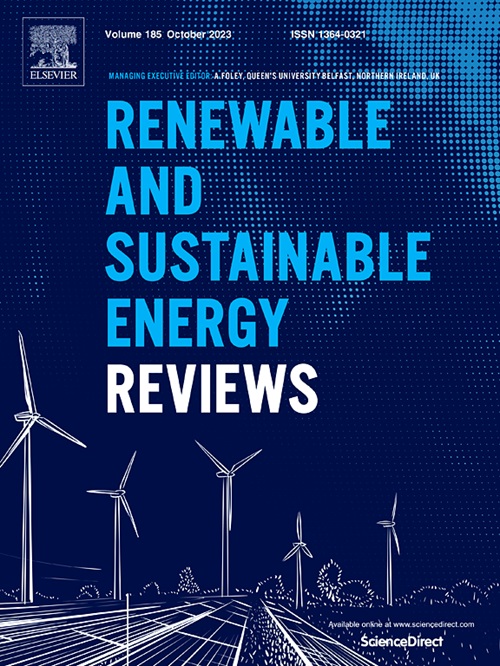Towards robust and scalable dispatch modeling of long-duration energy storage
IF 16.3
1区 工程技术
Q1 ENERGY & FUELS
引用次数: 0
Abstract
Energy storage technologies, including short-duration, long-duration, and seasonal storage, are seen as technologies that can facilitate the integration of larger shares of variable renewable energy, such as wind and solar photovoltaics, in power systems. However, despite recent advances in the techno-economic modeling of energy storage (particularly for short-duration applications), the operation and economics of long-duration energy storage are still incomplete in power systems modeling platforms. For instance, existing modeling approaches for long-duration storage are often based either on an oversimplified representation of power system operations or limited representation of storage technologies, e.g., evaluation of only a single application. This manuscript presents an overview of the challenges of modeling long-duration energy storage technologies in power system operations, as well as a discussion regarding the capabilities and limitations of existing approaches. Here two test power systems with high shares of both solar photovoltaics- and wind (70 %–90 % annual variable renewable energy shares) are used to assess long-duration energy storage dispatch approaches. Our results estimate that better dispatch modeling of long-duration energy storage could increase the associated operational value by 4 %–14 % and increase the standard capacity credit by 14 %–34 %. Thus, a better long-duration energy storage dispatch could represent significant cost saving opportunities for electric utilities and system operators. In addition, existing long-duration dispatch modeling approaches were tested in terms of both improved system value (e.g., based on production cost and standard capacity credit) and scalability (e.g., based on central processing unit time and peak memory usage). Both copper plate and nodal representations of the power system were considered. Although the end volume target dispatch approach, i.e., based on mid-term scheduling, showed promising performance in terms of both improved system value and scalability, there is a need for robust and scalable dispatch approaches for long-duration energy storage in transmission-constrained electric grids. Moreover, more research is required to better understand the optimal operation of long-duration storage considering extreme climate/weather events, reliability applications, and power system operational uncertainties.
为长时间储能建立稳健且可扩展的调度模型
储能技术,包括短时储能、长时储能和季节性储能,被认为是能够促进电力系统中更大比例可变可再生能源(如风能和太阳能光伏)整合的技术。然而,尽管最近在储能的技术经济建模(尤其是短时应用)方面取得了进展,但在电力系统建模平台中,长时间储能的运行和经济性仍然不完整。例如,现有的长期储能建模方法通常是基于对电力系统运行的过度简化表述或对储能技术的有限表述,如仅对单一应用进行评估。本手稿概述了电力系统运行中长期储能技术建模所面临的挑战,并讨论了现有方法的能力和局限性。这里使用了两个测试电力系统,其中太阳能光伏和风能的比例都很高(年可变可再生能源比例为 70%-90% ),用于评估长期储能调度方法。我们的结果估计,对长时间储能进行更好的调度建模可将相关运营价值提高 4%-14%,并将标准容量信用提高 14%-34%。因此,更好的长期储能调度可为电力公司和系统运营商带来显著的成本节约机会。此外,现有的长时间调度建模方法在提高系统价值(如基于生产成本和标准容量信用)和可扩展性(如基于中央处理单元时间和峰值内存使用)方面进行了测试。我们同时考虑了电力系统的铜板表示法和节点表示法。尽管基于中期调度的末端容量目标调度方法在提高系统价值和可扩展性方面表现出良好的性能,但在传输受限的电网中,仍需要针对长时间储能的稳健且可扩展的调度方法。此外,考虑到极端气候/天气事件、可靠性应用和电力系统运行的不确定性,还需要开展更多研究,以更好地了解长时间储能的最佳运行。
本文章由计算机程序翻译,如有差异,请以英文原文为准。
求助全文
约1分钟内获得全文
求助全文
来源期刊

Renewable and Sustainable Energy Reviews
工程技术-能源与燃料
CiteScore
31.20
自引率
5.70%
发文量
1055
审稿时长
62 days
期刊介绍:
The mission of Renewable and Sustainable Energy Reviews is to disseminate the most compelling and pertinent critical insights in renewable and sustainable energy, fostering collaboration among the research community, private sector, and policy and decision makers. The journal aims to exchange challenges, solutions, innovative concepts, and technologies, contributing to sustainable development, the transition to a low-carbon future, and the attainment of emissions targets outlined by the United Nations Framework Convention on Climate Change.
Renewable and Sustainable Energy Reviews publishes a diverse range of content, including review papers, original research, case studies, and analyses of new technologies, all featuring a substantial review component such as critique, comparison, or analysis. Introducing a distinctive paper type, Expert Insights, the journal presents commissioned mini-reviews authored by field leaders, addressing topics of significant interest. Case studies undergo consideration only if they showcase the work's applicability to other regions or contribute valuable insights to the broader field of renewable and sustainable energy. Notably, a bibliographic or literature review lacking critical analysis is deemed unsuitable for publication.
 求助内容:
求助内容: 应助结果提醒方式:
应助结果提醒方式:


